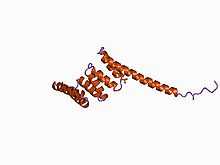Tetratricopeptide
| Tetratricopeptide repeat | |||||||||
|---|---|---|---|---|---|---|---|---|---|
 | |||||||||
| Identifiers | |||||||||
| Symbol | TPR_1 | ||||||||
| Pfam | PF00515 | ||||||||
| Pfam clan | CL0020 | ||||||||
| InterPro | IPR001440 | ||||||||
| SCOP | 1a17 | ||||||||
| SUPERFAMILY | 1a17 | ||||||||
| CDD | cd00189 | ||||||||
| |||||||||
The tetratricopeptide repeat (TPR) is a structural motif. It consists in a degenerate 34 amino acid sequence motif identified in a wide variety of proteins. It is found in tandem arrays of 3–16 motifs,[1] which form scaffolds to mediate protein–protein interactions and often the assembly of multiprotein complexes. These repeats usually fold together to produce a single, linear solenoid domain called TPR domain. Proteins with such domains include the anaphase-promoting complex (APC) subunits cdc16, cdc23 and cdc27, the NADPH oxidase subunit p67-phox, hsp90-binding immunophilins, transcription factors, the PKR protein kinase inhibitor, the major receptor for peroxisomal matrix protein import PEX5 and mitochondrial import proteins.
Structure
The structure of the PP5 protein was the first structure to be determined. The structure solved by X-ray crystallography by Das and colleagues showed that the TPR sequence motif was composed of a pair of antiparallel alpha helices.[2] The PP5 structure contained 3 tandem TPR repeats which showed the sequential TPR repeats formed an alpha-helical solenoid structure.
Examples
Human genes encoding proteins containing this motif include:
- AAG2, ANAPC7
- BBS4
- CABIN1, CDC16, CDC23, CDC27, CNOT10, CTR9
- DNAJC3, DNAJC7, DYX1C1
- FAM10A4, FAM10A5, FKBP4, FKBP5, FKBP8, FKBPL
- GPSM1, GPSM2, GTF3C3
- IFIT1, IFIT1L, IFIT2, IFIT3, IFIT5, IFT140, IFT88
- KLC1, KLC2, KLC3, KLC4, KNS2
- LONRF2
- NARG1, NARG1L, NASP, NCF2, NFKBIL2, NOXA1, NPHP3
- OGT
- PEX5, PEX5L, PPID, PPP5C, PRPF6
- RANBP2, RANBP2L2, RANBP2L6, RAPSN, RGPD5, RGPD7, RPAP3
- SGTA, SGTB, SH3TC1, SH3TC2, SPAG1, SRP72, ST13, STIP1, STUB1, SUGT1
- TMTC1, TMTC2, TMTC3, TMTC4, TOMM34, TOMM70A
- TTC1, TTC3, TTC4, TTC5, TTC6, TTC7A, TTC7B, TTC8, TTC9C, TTC12, TTC13, TTC14, TTC15, TTC16, TTC17, TTC18, TTC21A, TTC21B, TTC22, TTC24, TTC25, TTC27, TTC28, TTC29, TTC30A, TTC30B, TTC31, TTC33, TTC37
- UNC45A, UNC45B, UTX, UTY
- WDTC1
- ZC3H7B
References
- ↑ Blatch GL, Lässle M (November 1999). "The tetratricopeptide repeat: a structural motif mediating protein-protein interactions". BioEssays 21 (11): 932–9. doi:10.1002/(SICI)1521-1878(199911)21:11<932::AID-BIES5>3.0.CO;2-N. PMID 10517866.
- ↑ Das AK, Cohen PW, Barford D (March 1998). "The structure of the tetratricopeptide repeats of protein phosphatase 5: implications for TPR-mediated protein-protein interactions". EMBO J. 17 (5): 1192–9. doi:10.1093/emboj/17.5.1192. PMC 1170467. PMID 9482716.
External links
- Eukaryotic Linear Motif resource motif class LIG_TPR
- Eukaryotic Linear Motif resource motif class TRG_PTS1
Further reading
- Lima Mde, F; Eloy, NB; Pegoraro, C; Sagit, R; Rojas, C; Bretz, T; Vargas, L; Elofsson, A; de Oliveira, AC; Hemerly, AS; Ferreira, PC (Nov 18, 2010). "Genomic evolution and complexity of the Anaphase-promoting Complex (APC) in land plants.". BMC plant biology 10: 254. doi:10.1186/1471-2229-10-254. PMC 3095333. PMID 21087491.
- Das AK, Cohen PW, Barford D (March 1998). "The structure of the tetratricopeptide repeats of protein phosphatase 5: implications for TPR-mediated protein-protein interactions". EMBO J. 17 (5): 1192–9. doi:10.1093/emboj/17.5.1192. PMC 1170467. PMID 9482716.
- Whitfield C, Mainprize IL (February 2010). "TPR motifs: hallmarks of a new polysaccharide export scaffold". Structure 18 (2): 151–3. doi:10.1016/j.str.2010.01.006. PMID 20159460.
- Krachler AM, Sharma A, Kleanthous C (July 2010). "Self-association of TPR domains: Lessons learned from a designed, consensus-based TPR oligomer". Proteins 78 (9): 2131–43. doi:10.1002/prot.22726. PMID 20455268.
- Schapire AL, Valpuesta V, Botella MA (September 2006). "TPR Proteins in Plant Hormone Signaling". Plant Signal Behav 1 (5): 229–30. doi:10.4161/psb.1.5.3491. PMC 2634123. PMID 19704665.
- Cortajarena AL, Regan L (May 2006). "Ligand binding by TPR domains". Protein Sci. 15 (5): 1193–8. doi:10.1110/ps.062092506. PMC 2242500. PMID 16641492.
- D'Andrea LD, Regan L (December 2003). "TPR proteins: the versatile helix". Trends Biochem. Sci. 28 (12): 655–62. doi:10.1016/j.tibs.2003.10.007. PMID 14659697.
- Goebl M, Yanagida M (May 1991). "The TPR snap helix: a novel protein repeat motif from mitosis to transcription". Trends Biochem. Sci. 16 (5): 173–7. doi:10.1016/0968-0004(91)90070-C. PMID 1882418.